

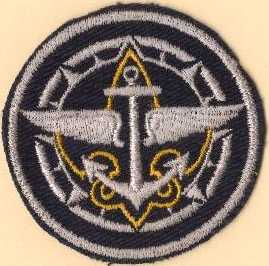 Explorers
(1949-1958)
Explorers
(1949-1958)
Overview
In September of 1949, after researching the needs of older boys, the
Senior Scouting program was changing into the Explorer program. Explorer
Scouts became Explorers. Air Scouts became Air
Explorers. Sea Scouts became Sea Explorers.
The age for these programs was lowered from 15 to 14. Also, National
changed the policy such that when a boy turned 14, he automatically became
an Explorer. He could continue in a Boy Scout Troop, or join an Explorer
Crew within his troop, or join a separate Explorer unit.
For more information about the new Air Explorer and Sea Explorer programs, see their pages. The rest of this page will deal only with the new Explorer program.
The new Explorer program also took as its symbol the compass-anchor-wings emblem created for the Senior Scout Outfit.
In 1959, based on an extensive research project dealing with the needs and wants of older boys, this program was replaced by the new Exploring program.
Explorer Program
The Explorer program was changed and expanded from the Explorer Scout
program. Whereas the old Explorer Scout program had an explicit advanced
outdoor emphasis, the new Explorer program expanded its purpose to attract
more older boys. Explorer Posts were supposed to have a well rounded
program four activity fields: Adventuring in the outdoors, Getting along
socially with others, Being of service to others, and Exploring lifework
possibilities. More so then under the Senior Scout program, Explorer
Posts were more likely to specialize in some area of interest, which might
be hobby based or vocational based.
Explorer Uniforms
Explorers continued with their forest green uniforms. These could be
worn with a brown tie. A white web belt and optional web leggings
were also created. They could wear the khaki scout uniform with maroon
tie. Forest green shorts were not produced, so Explorers would have
to wear the khaki shorts. The strips on the shirts now read "Explorers,
BSA". In 1954, the brown on green numerals and community and state strips
were dropped. Afterwards, Explorers would wear the standard white
on red numbers and community strips.


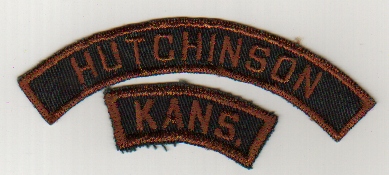
Explorers also continued the use of the fatigue uniform that was started under Senior Scouting. It consisted of blue dungarees (jeans), a white T-shirt with the Explorer logo, blue fatigue cap and optional blue zipper jacket and white leggings. This uniform was dropped at the end of 1953, but the T-shirt was continued.
In 1954, bright red wool and poplin jackets were authorized for used by Explorers and leaders. The wool jacket (or jac-shirt) first started to be used at Philmont. At first, only Explorers were allowed to use the red jackets. It wouldn't be until the late 60s or so that the red jacket became the general BSA jacket for use by everyone.
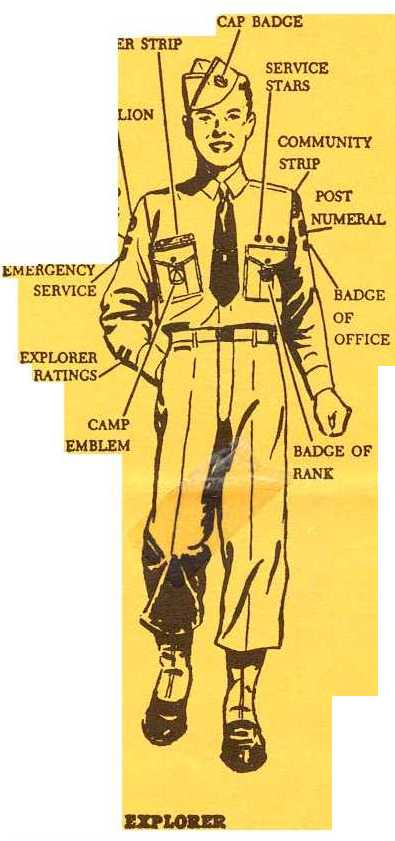
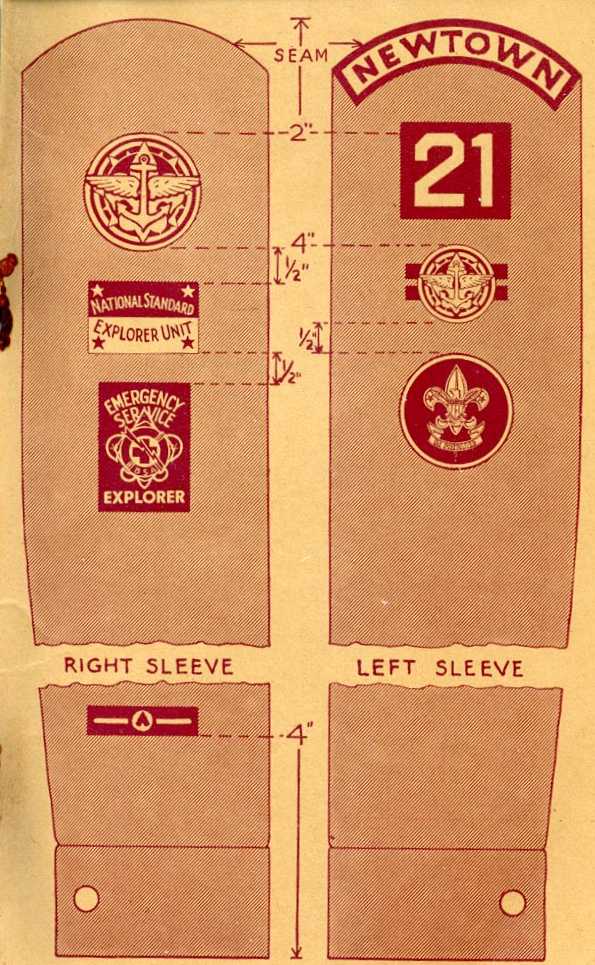
Several lapel and collar pins were made, both
universal and for advisors. Collar pins were 7/8 in and lapel pins
were 5/8 in
 |
 |
Universal pin in green?? | |
 |
Advisor
Lapel Pin in blue NO PICTURE |
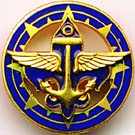 |
 |
 |
Advisor
Lapel Pin in green NO PICTURE |
Assistant
Advisor Collar Pin in green NO PICTURE |
Assistant
Advisor Lapel Pin in green NO PICTURE |
Explorer Advancement Program
The new Explorer program also revamped its advancement program.
No longer using outdoors inspired ranks, instead it had the ranks of Apprentice-Bronze-Gold-Silver.
Advancement through the ranks was done
by earning one of several Rating Strips.
These Rating Strips were inspired by the Air Scout Specialist Badges, but
unlike the Air Scout program, earning the Ratings was required for earning
rank. To earn them, an Explorer had to participate in an outdoor
event, social event, and a service event, as well as do several specific
requirements for that rating. One thing was discontinued was allowing
Explorers to earn any Senior Scouting advancement program. Now only
Sea Explorers could earn Sea Explorer advancement and only Sea Explorer
Advancement, Air Explorers were the only ones to earn Air Explorer advancement
and only Air Explorer advancement, and Explorers in Posts and Troops were
the only ones to earn Explorer advancement and only Explorer advancement.
At first, medals for Bronze and Gold were also made. It appears these were quickly discontinued. They are very rare.
For rank requirements, go HERE.
For rating strips requirements, go HERE.
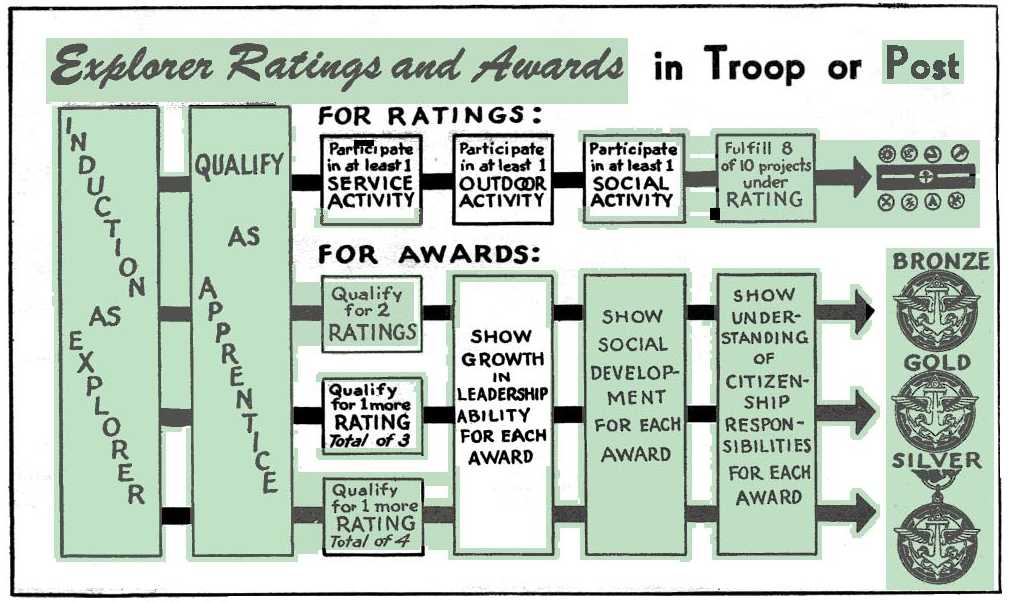
In 1954, with the Air Explorers using the Explorer advancement program, the color of the patches were changed and 3 ratings were added to replace unique ones from the Air Explorer program. These new ratings were Construction, Mechanics, and Weather. A new Silver Award was also created that in design was inspired by the Ace Award medal.
Also, Explorers now had alternative ways of earning Eagle Scout. In addition to being able to earn Star, Life, and Eagle if they had earned First Class in a Boy Scout Troop, Explorers could also progress through Star-Life-Eagle if they had earned either the Bronze Award or the Outdoor Skills Rating. The same was true for Sea Explorers and Air Explorers of that time. Later around 1956 or so, Star patches were made with a forest green background for wearing on the forest green Explorer shirt. Life Scout patches of that time were just the heart patch, so there was no need to do so. Why they didn't do so sooner is unclear, as Star, Life, and Eagle patches on white and blue have existed for a long time for Sea Scouts/Sea Explorers to use.
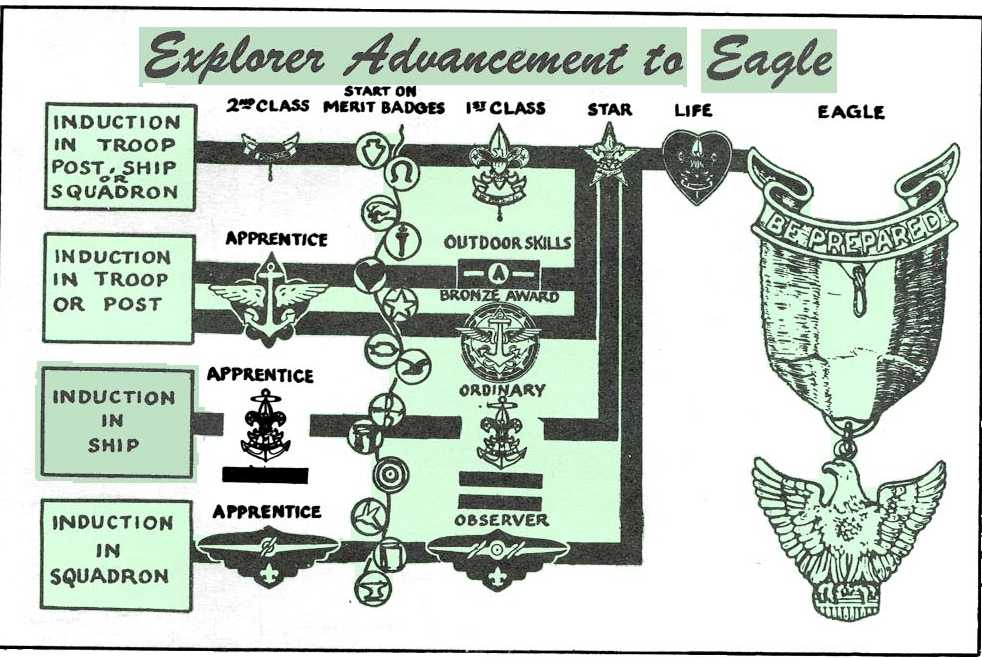
 Apprentice Apprentice |
 Bronze Bronze |
 Gold Gold |
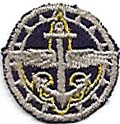 Silver Silver |
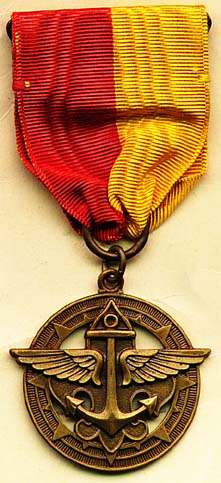 |
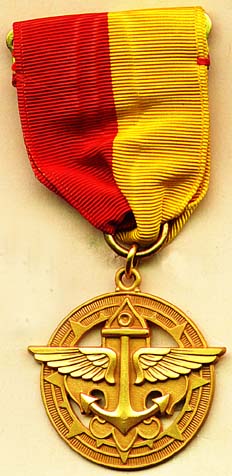 |
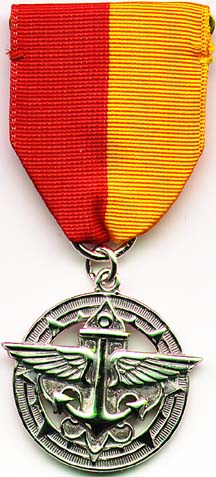 |
|
 |
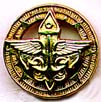 |
  |
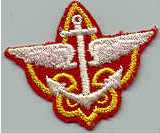 Apprentice Apprentice |
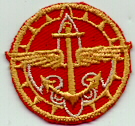 Bronze Bronze |
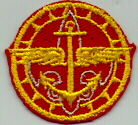 Gold Gold |
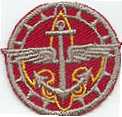 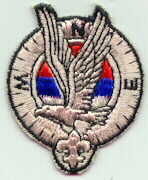 Silver Silver |
 Silver
Medal, Type 2 Silver
Medal, Type 2 |
  |
 Aviation Aviation |
 Communication Communication |
 Craft
Skills Craft
Skills |
 Emergency
Skills Emergency
Skills |
 Navigation Navigation |
 Outdoor
Skills Outdoor
Skills |
 Physical
Fitness Physical
Fitness |
 Seamanship Seamanship |
 Vocational
Exploration Vocational
Exploration |
|
| unknown | unknown |
Explorer Unit Organization
With the new Explorer program, some changes were made in the officer
names. Post Guide became Senior Crew Leader, and Assistant Post Guide
became Deputy Senior Crew Leader. Other terms stayed the same.
Initially, office insignia was the Senior Scout Outfit insignia recycled. In 1954, with the changes in the color of the rank patches, office patches also changed color from dark blue to forest green.
In addition, Crews were expected to establish four committees, drawing
from the entire Post. Each of the four were devoted to one of the
activity fields of Exploring: Outdoor, Indoor (Vocation), Social, and Service
| Boy Scout Troop | Explorer Post |
| Scoutmaster | Post Advisor |
| Senior Patrol Leader | Senior Crew Leader |
| Patrol | Crew |
| Patrol Leader | Crew Leader |
| Scribe | Post Secretary |
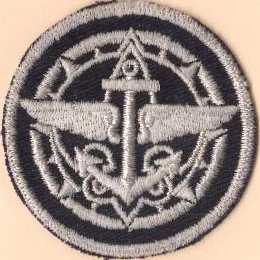 Post
Advisor Post
Advisor |
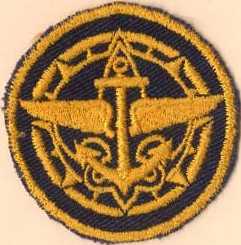 Assistant
Post Advisor Assistant
Post Advisor |
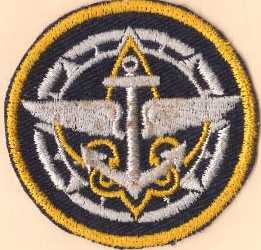 Senior
Crew Leader Senior
Crew Leader |
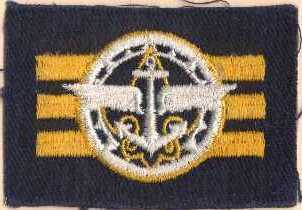 Deputy
Senior Crew Leader Deputy
Senior Crew Leader |
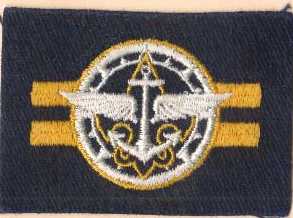 Crew
Leader Crew
Leader |
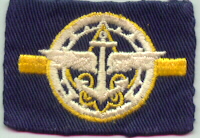 Assistant
Crew Leader Assistant
Crew Leader |
 Post
Secretary Post
Secretary |
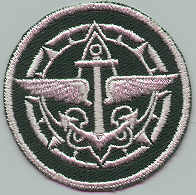 Post
Advisor Post
Advisor |
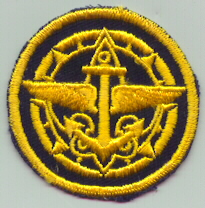 Assistant
Post Advisor Assistant
Post Advisor |
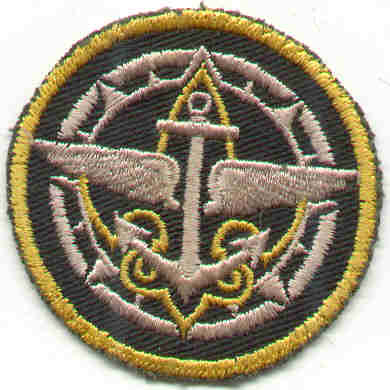 Senior
Crew Leader Senior
Crew Leader |
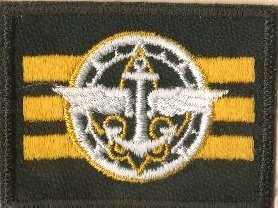 Deputy
Senior Crew Leader Deputy
Senior Crew Leader |
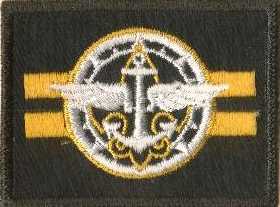 Crew
Leader Crew
Leader |
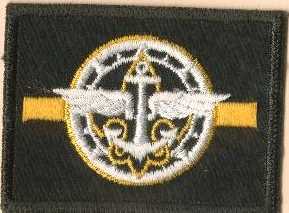 Assistant
Crew Leader Assistant
Crew Leader |
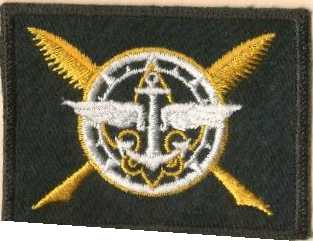 Secretary Secretary |
Miscellaneous
National would continue the use of "Standard Explorer Unit" awards
from the previous "Standard Senior Scout Unit" awards. These awards
were given to any Explorer unit (Post, Ship, Squadron) which meet certain
criteria at the local, regional, or national levels. To see the requirements,
go here.
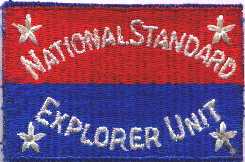 |
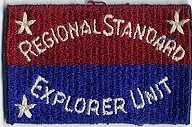 |
 |
In 1957, a program called "Citizens Now" Conference was started. It was expected that every council run it by June of 1957. The conference was to be a 2.5 day event at a local college/university. A booklet explained the program, "Citizens Now" Conference Workbook (#3046), and a patch was also made. It was popular enought that many ran it again in 1958. With the changes in the Explorer program after 1958, this event was dropped.
Literature
The basic manual for the Explorer program was the Explorer Manual,
which was a revision of the previous Explorer Scout Manual.
This manual gave detailed information on how Explorers operated, and their
new advancement program.
The only manual for adult leaders was the generic Hints on Explorer Leadership, which is a slight update of the previous Hints on Senior Scouting Leadership. Why nothing equivalent to a Scoutmaster Handbook was produced is unknown. This booklet gives only a vary basic overview of leadership information for the Explorer programs.
National also published the Explorer Program Quarterly starting in 1954. These lasted until 1966.
There were Explorer Leader's Program Notebooks as well, which
were a continuation of the Senior Scouting Program Notebook started
back in 1946. These lasted atleast until 1968.
| Explorer Manual (#3506)
2nd edition 1st 1950, Jan 330p+4p 50000 2nd 1950, Nov 330p+4p 3rd edition 1st 1952,Mar 330p+4p 50000 2nd 1953,Apr 50000 3rd 1954,Apr 380p+4p 50000 4th 1954,Aug 386p+14p 60000 5th 1955,Apr 386p+14p 60000 4th Edition 1st 1956,May 60000 2nd 1957,Mar 3rd 1958,Jan paperback book, Ted S. Holstein, editor |
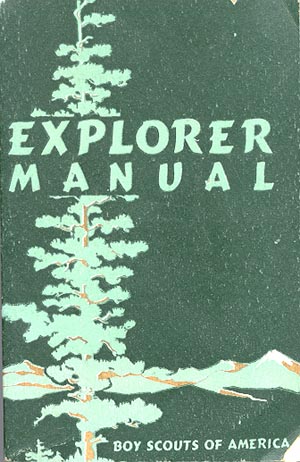 |
| Hints on Explorer Leadership (#3482)
1949 20000 1950 25000 1951 25000 1954 11000 1955 1957 (other printings??) paperback, 92pg |
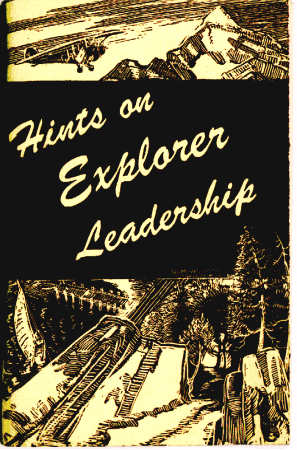 |
| Explorer Leader's Program Notebook
several editions: 1950-51 (shown) 20000 1951-52 (shown) 35000 1952-53 (shown) 45000 1953-54 (shown) 1954-55 (shown) 45000 1955-56 (shown) 1956-57 65000 1957-58 (shown) 65000 paperback, 128pg |
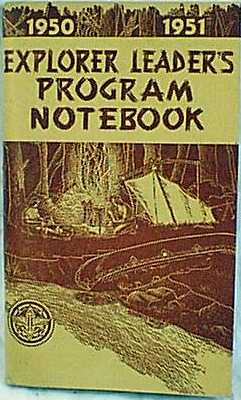    |
| Explorer Program Quarterly
V1 winter 1954; spring 54; summer 54; fall 54 V2 winter 54-55; spring 55; summer 55; fall 55 V3 winter 56; spring 56; summer 56; fall 56 V4 winter 56-57; spring 57; summer 57; fall 57 V5 winter 57; spring 58; summer 58; fall 58 about 24 pages in length |
 |
| year | membership | units | Ranger awards | Silver awards |
| 1949 | 63594 | ? | 611 | 0 |
| 1950 | 92860 | ? | 1218* | 64 |
| 1951 | 100983 | ? | 78* | 422 |
| 1952 | 106140 | ? | -- | 741 |
| 1953 | 115866 | ? | -- | 971* |
| 1954 | 136819 | ? | -- | 1212* |
| 1955 | 152645 | 12020 | -- | 1615* |
| 1956 | 172773 | 13414 | -- | 1957* |
| 1957 | 193449 | 14721 | -- | 2415* |
| 1958 | 219660 | ? | -- | 6890* |
*- after the official end of the "Ranger
program" in September of 1949, there was a two year grace period for those
earning the award.
*- in 1953, earning of the Silver Award became optional for Air Explorers,
after Jan of 1955, it became mandatory. Thus these numbers also include
Silver Awards earned by Air Explorers as well as Explorers
Source: BSA Annual Reports, as reported in Art Hyman's book The Scout
in Aviation.
Updated: 09/04/2002mrb